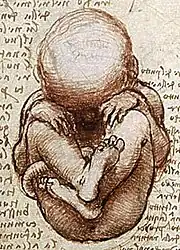Dying
Dying is the final stage of life that lead to death.
| Part of a series on |
| Human growth and development |
|---|
 |
| Stages |
| Biological milestones |
|
| Development and psychology |
|
|
Developmental stage theories |
|
|
Signs of dying
The National Cancer Institute in the United States (US) advises that the presence of some of the following signs may indicate that death is approaching:[1][2]
- Drowsiness, increased sleep, and/or unresponsiveness (caused by changes in the patient's metabolism).
- Confusion about time, place, and/or identity of loved ones; restlessness; visions of people and places that are not present; pulling at bed linens or clothing (caused in part by changes in the patient's metabolism).
- Decreased socialization and withdrawal (caused by decreased oxygen to the brain, decreased blood flow, and mental preparation for dying).
- Decreased need for food and fluids, and loss of appetite (caused by the body's need to conserve energy and its decreasing ability to use food and fluids properly).
- Loss of bladder or bowel control (caused by the relaxing of muscles in the pelvic area).
- Darkened urine or decreased amount of urine (caused by slowing of kidney function and/or decreased fluid intake).
- Skin becoming cool to the touch, particularly the hands and feet; skin may become bluish in color, especially on the underside of the body (caused by decreased circulation to the extremities).
- Rattling or gurgling sounds while breathing, which may be loud (death rattle); breathing that is irregular and shallow; decreased number of breaths per minute; breathing that alternates between rapid and slow (caused by congestion from decreased fluid consumption, a buildup of waste products in the body, and/or a decrease in circulation to the organs).
- Turning of the head toward a light source (caused by decreasing vision).
- Increased difficulty controlling pain (caused by progression of the disease).
- Involuntary movements (called myoclonus), increased heart rate, hypertension followed by hypotension,[3] and loss of reflexes in the legs and arms are additional signs that the end of life is near.
Culture
In the late Middle Ages, documents known as Ars moriendi were circulated in Western Europe to help people cope with dying. The documents describe the process of dying as involving Devils intervention, however the God would let the dying person experience heaven and be promised to get accepted into heaven. Many related manuals also described that caretakers for those dying shouldn't gave them false hope of possible recovery, but rather help them to be able to accept death as much as possible.
In Chinese Buddhism, it is said that dying patients will experience phases between the state of torment and the state of exultation, and that the duty of caretaker in this stage is to help the dying patient stay in the state of Buddhist exultation, through Buddhist prayers known as Nianfo.
See also
| Wikimedia Commons has media related to Dying. |
- Assisted dying (disambiguation)
- End-of-life care
- Last rites
- Near-death experience
- Terminal illness
References
- ↑ "Physical Changes as You Near the End of Life". www.cancer.org. Retrieved 2020-04-30.
- ↑ "End-of-Life Care: Questions and Answers". NCI Factsheet. 30 October 2002.
- ↑ Linda LE, Ferris FD, von Gunten C. "The Last Hours of Living: Practical Advice for Clinicians". Medscape. Archived from the original on 28 January 2017. Retrieved 17 November 2017.